Mixed Sando is a classic set of Japanese sandwiches made with soft and tender Japanese milk bread. They‘re found at restaurants, bakeries, and konbini (convenience stores) all across Japan. Home cooks make them for bento lunches and family picnics, too. Here, I show you three popular fillings—tuna salad, tamago (egg salad), and ham and cheese with lettuce.

Japanese sandwiches like Katsu Sando and Tamago Sando have found their spots in today’s food world and pop culture. But as you may have guessed, there’s more to discover! Today I’m introducing one of the most classic sandwiches that should be on your radar: Mixed Sando (ミックスサンド).
Tucked inside fluffy slices of crustless bread and served as a set, these sandwiches are perfectly simple yet unmistakably comforting and nostalgic. Let’s make mixed sando at home!
Table of Contents
What is Japanese Sandwich ‘Mixed Sando’?
Mixed sando (ミックスサンド) typically refers to three different sandwiches served as a set. Nothing fancy, but it is a standard style of sandwich in Japan. The fillings include:
- Ham and cheese with lettuce
- Tuna salad
- Egg salad (tamago)
Both tuna and egg sandwiches are soft and creamy. The ham, cheese, and lettuce sandwiches add a nice crisp contrast. Together, they make a tasty combo that is well-balanced in texture, taste, and visual.
You can find mixed sandos everywhere: at cafes, restaurants, grocery stores, bakeries, and konbini (convenience stores). Because they are satisfying and nutritious, Japanese home cooks also love making these mixed sandwiches for their children’s bentos and picnics.

How to Make Mixed Sando
Ingredients You’ll Need
- Shokupan (Japanese milk bread) – The key component that makes the sandwich uniquely Japanese. I’ll talk about this more below.
- Butter – You used spreadable salted butter
- Kewpie Japanese mayonnaise – You can buy it on Amazon or make it yourself
- Mustard – Optional; I skipped it as my family is not fond of mustard.
- Salt and black pepper
- For Ham and Cheese Sandwich – Sliced ham, sliced cheese (I use Swiss), iceberg lettuce, and sliced Japanese/Persian cucumber
- For Tuna Sandwich – Canned tuna and minced onion
- For Egg Sandwich – Hard-boiled eggs and milk
Overview: Cooking Steps
- Make tuna salad and egg salad.
- Prepare the rest of the ingredients (rinse the lettuce, slice the cucumber, etc.).
- Cut the shokupan (Japanese milk bread) into thin slices (about 1-1.2 cm) and spread the butter, mayonnaise, and mustard (optional) on one side of the slice.
- Add the sandwich fillings for each type of sandwich and press it down by placing a plate on top.
- Slice off the crust of the sandwiches and cut them into smaller rectangular shapes.

Types of Sandwich Bread You Need
One distinct characteristic of Japanese sandwiches is the use of Shokupan (Japanese Milk Bread).
How is it different from the western style loaf of sandwich bread? Shokupan is known for its milky-sweet taste, incredibly fluffy texture, and pillowy softness. There is a lightness to the bread, which I think defines the essence of Japanese sandwiches.
You can either make your own milk bread or pick up a loaf from your local Asian grocery store. The pre-sliced shokupan for sandwiches comes with a 1 cm or 1.2 cm thickness, so you don’t have to cut the bread yourself. However, if you plan to make the shokupan for sandwiches, it’s not easy to hand slice the bread to an even 1-1.2 cm thickness.
I used Black Sesame Shokupan for this mixed sando recipe, but you can certainly use plain white shokupan.
If you really don’t have access to Japanese milk bread but still wish to make the recipe, go for the fluffiest, softest white bread you can find.

When I was growing up in Yokohama, Japan, the popular local bakery called Pompadour had mixed sandos made with black sesame milk bread. I have major cravings for sandwiches, so I made one for this recipe.
The black sesame seeds add a lovely nutty and earthy taste to the soft milk bread. If you have tried the classic plain shokupan, you need to make this black sesame version today as it is the next-level bread for Japanese sandwiches.
Tips to Make Japanese Sandwich ‘Mixed Sando’
- Use butter to shield the bread from moisture. I highly recommend spreading the butter as it acts as a waterproof shield/barrier so the bread stays dry, not soggy.
- Use Kewpie Japanese mayonnaise. For Japanese sandwiches, Japanese mayo is a must. It has a distinctly sweet, sour, umami-rich flavor that is crucial for the sandwiches.
- Press down the sandwich before slicing. Place a plate on top of the sandwiches. Weighing the sandwich helps to compress everything so the bread and the ingredients are bound together better.
- Cut off the crust of the bread. This is for the classic Japanese sandwich look. I do eat the crust when I make the sandwiches… no food waste. 🙂

What to Serve with Japanese Sandwiches
- Royal Milk Tea
- Crispy Baked Salmon Nuggets
- Shrimp and Broccoli Salad
- Seafood Salad with Vinaigrette
- Miso Butter Cookies
Other Classic Japanese Sandwiches





Wish to learn more about Japanese cooking? Sign up for our free newsletter to receive cooking tips & recipe updates! And stay in touch with me on Facebook, Pinterest, YouTube, and Instagram.

Japanese Sandwich (Mixed Sando)
Ingredients
For the Sandwiches
- shokupan (Japanese milk bread) (6 thin slices total; I used Black Sesame Shokupan, but you can also use regular Shokupan)
- salted butter (at room temperature; I use spreadable butter)
- Japanese Kewpie mayonnaise (or make my homemade Japanese mayonnaise)
- mustard (optional; I skipped it as my family is not fond of it)
For the Tuna Salad
- ⅛ onion
- ½ (5-ounce) can albacore tuna (preferably packed in olive oil) (well drained; I used a whole 2.8-ounce (80 g) can of Japanese brand canned tuna)
- 2 Tbsp Japanese Kewpie mayonnaise
- freshly ground black pepper
- Diamond Crystal kosher salt
For the Egg Salad
- 3 large large eggs (50 g each w/o shell) (see my Tamago Sando blog post for additional details)
- ¼ tsp sugar
- ¼ tsp Diamond Crystal kosher salt
- ⅛ tsp freshly ground black pepper
- 2 tsp milk
- 2 Tbsp Japanese Kewpie mayonnaise
For the Ham and Cheese Filling
- 2 leaves iceberg lettuce (trimmed to the size of a shokupan slice)
- 2 slices ham
- 2 slices Swiss cheese
- 6 slices Japanese or Persian cucumber (thinly sliced diagonally)
Instructions
To Make the Tuna Salad
- Gather the tuna salad ingredients. Then, mince ⅛ onion and soak the pieces in water for 5 minutes to remove the bitterness and astringency.

- Squeeze the water out and add to a bowl along with ½ (5-ounce) can albacore tuna (preferably packed in olive oil), well drained.

- Add 2 Tbsp Japanese Kewpie mayonnaise, Diamond Crystal kosher salt, and freshly ground black pepper. Mix with a fork. Flake the tuna chunks into smaller pieces and incorporate the seasonings well. Set aside. You can cover it and store in the refrigerator while you make the egg salad.

To Make the Egg Salad
- Gather the egg salad ingredients. This recipe makes enough filling for two Tamago Sando. You can store the leftover egg salad in an airtight container for up to 2 days in the refrigerator. Put 3 large large eggs (50 g each w/o shell) in a medium saucepan and add enough water to cover by one inch (2.5 cm). Bring it to a boil on medium heat. Once boiling, cook for 12 minutes.

- Once it’s finished cooking, transfer the eggs to iced water to stop the cooking. Let them cool completely and peel the eggshells.

- Transfer the peeled eggs to a bowl and mash with a fork. Try to mash the egg whites into small, same-sized pieces.

- Add ¼ tsp sugar and ¼ tsp Diamond Crystal kosher salt.

- Add ⅛ tsp freshly ground black pepper and 2 tsp milk. Taste and add more salt and pepper if needed.

- Add 2 Tbsp Japanese Kewpie mayonnaise and mix very well.

To Assemble the Sandwiches
- Gather the filling ingredients for the three types of sandwiches.

- If your bread is not pre-sliced, cut the shokupan (Japanese milk bread) into 6 thin slices, each about ⅓ to ½ inch (1 to 1.2 cm) thick. Lay out the 6 bread slices for the 3 sandwiches.

- Using a butter knife, spread a thin layer of salted butter on all 6 slices. For the Tamago Sando, scoop the egg salad onto 1 of the slices and spread to distribute evenly.

- For the Ham and Cheese Sando, spread Japanese Kewpie mayonnaise (and mustard, if desired) onto 2 of the buttered slices. On 1 of those slices, layer 2 leaves iceberg lettuce, 2 slices ham, 2 slices Swiss cheese, and 6 slices Japanese or Persian cucumber on top.

- For the Tuna Sando, scoop the tuna salad onto 1 of the remaining sandwich slices and spread evenly. Put the other slice of bread on top, buttered side down. For the Ham and Cheese Sando, put the slice on top that has both the butter and mayonnaise, spread side down. Finally, put the remaining slice of bread on top of the egg salad, buttered side down. Then, place plates on top of the sandwiches to compress the ingredients slightly. Set aside for 5 minutes.

- After 5 minutes, remove the plates. If you‘d like, cut the crusts off the sandwiches. Tip: Don't throw away the crusts and repurpose them to make Shokupan Crust Rusks. These crunchy, buttery snacks are so delicious! You can make them now or freeze those crust strips and make them later.

- Cut each sandwich horizontally into thirds for three equal rectangular pieces. They‘re now ready to serve. For each serving, arrange one piece of each type of sandwich onto a plate for a total of three pieces. In the photo to the right, I show how to present two servings in a carry-out box.

To Store
- You can keep any leftovers in an airtight container and store them in the refrigerator for up to 24 hours.


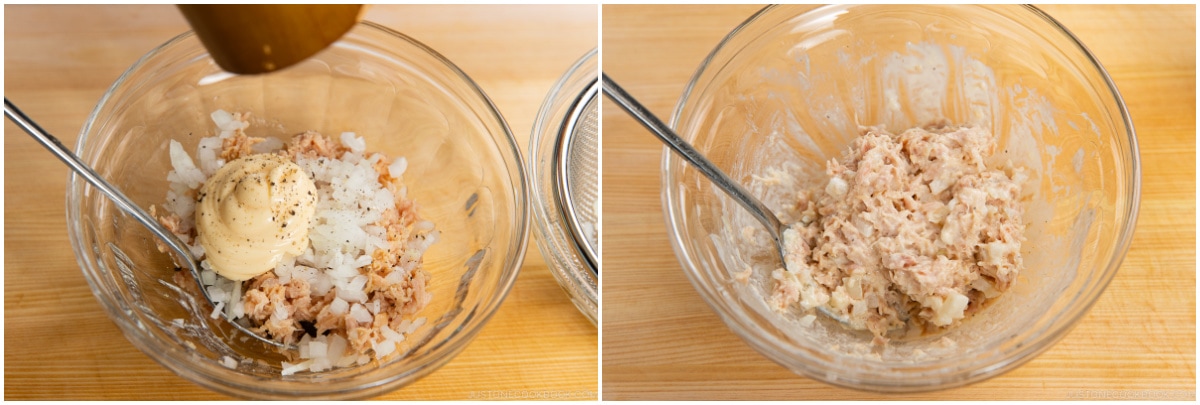
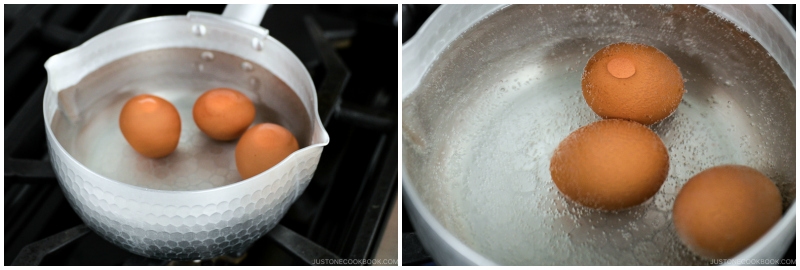
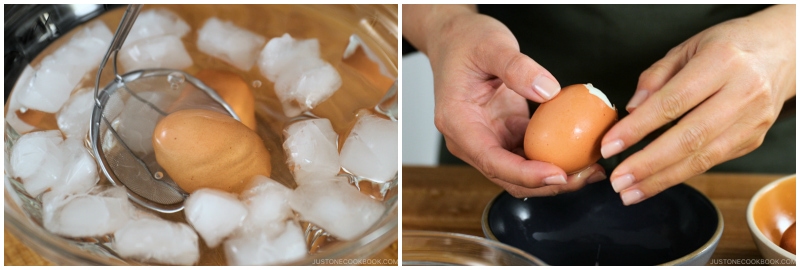

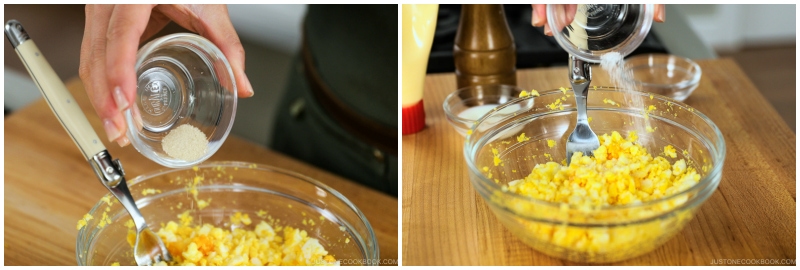
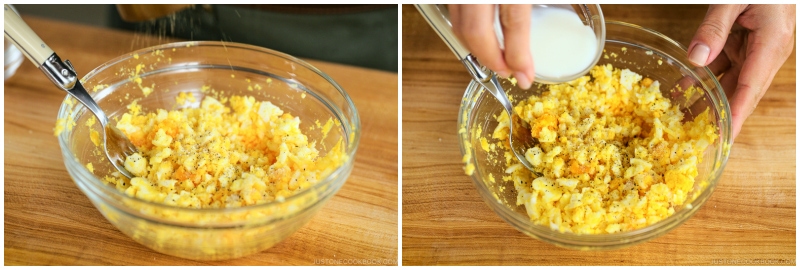



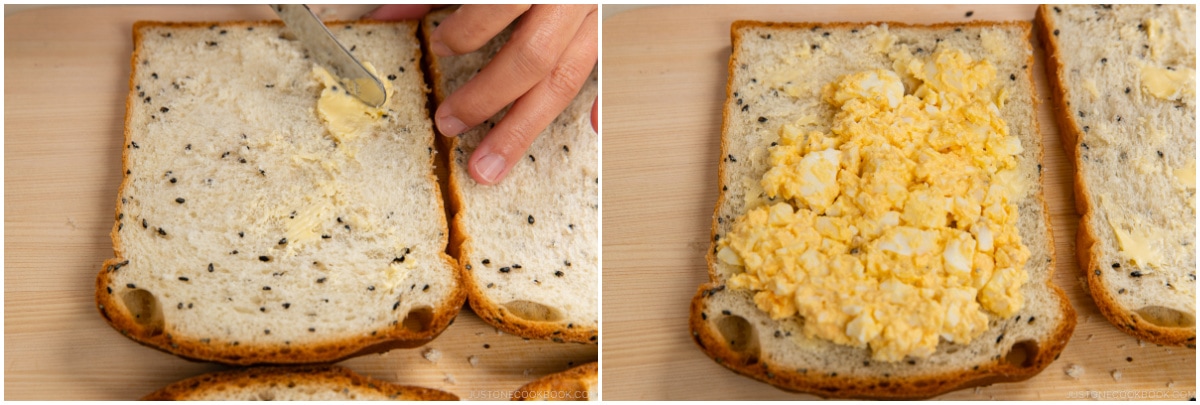














Hello!
Big fan of the site!
Last week I tried a mixed sando including a cucumber-ham-mayo one from 7/11 tokyo. After checking the ingredients I noticed that it had some Karashi mixed with the mayo which I loved! Special punch of flavor in an otherwise simple sandwich!
Naturally I wanted to replicate it but at the supermarket I saw 2 types of S&B からし: regular one and “和風”.
Could you explain a bit the difference between those?
Hi Adrian! Thank you for being such a big fan of ours! 🥰
和風からし(wafu-karashi) is made with coarsely ground mustard and has a rich aroma of deep mustard spiciness.
We hope this helps!
Can the contents of the bread be filled with meat slices?
Hi Biomedis, Mixed sando typically refers to three different sandwiches served as a standard set style of sandwich in Japan. The fillings include:
Ham and cheese with lettuce
Tuna salad
Egg salad (Tamago)
Yes. You can fill it with meat slices, but it is called differently. Please check out Nami’s other sandwich recipes: https://www.justonecookbook.com/search/?q=sando
We hope this helps!🙂
How about adding mayonnaise with chili sauce?
Hi, Biomedis! Sure, it might go well, too.🙂
Thank you for reading Nami’s post and trying her recipe!
Namiko, you make the simplest foods very special. Thank you for sharing your delicious recipes and teaching us how to serve so beautifully!
Hi Danni! Thank you very much for your kind words to Nami!🥰
She is so happy to hear you’re enjoying the recipes and everything else that we share.
Happy Cooking!
can i adapt this recipe and it be successfully baked in a ( Zojirushi BB-SSC10) Bread Machine?
Hi Milagros, Thank you for reading Nami’s post and trying her recipe!
To bake the Shokupan, you can use Nami’s Shokupan recipe/ingredient amount to bake them in the bread machine. However, kneading speed, proofing, and baking settings might be slightly different and result in a difference in texture.